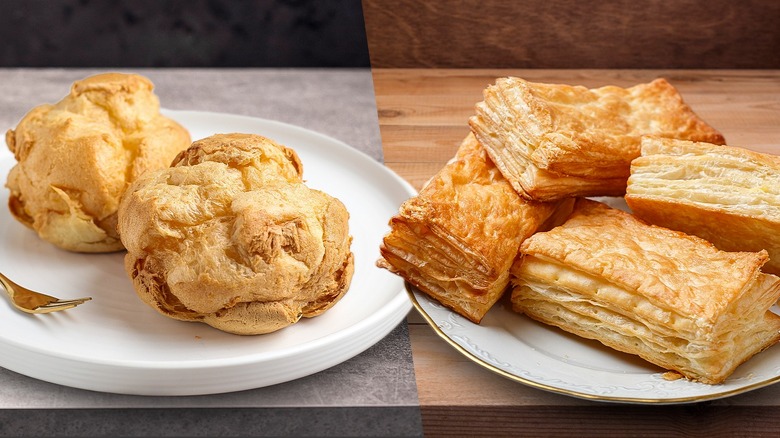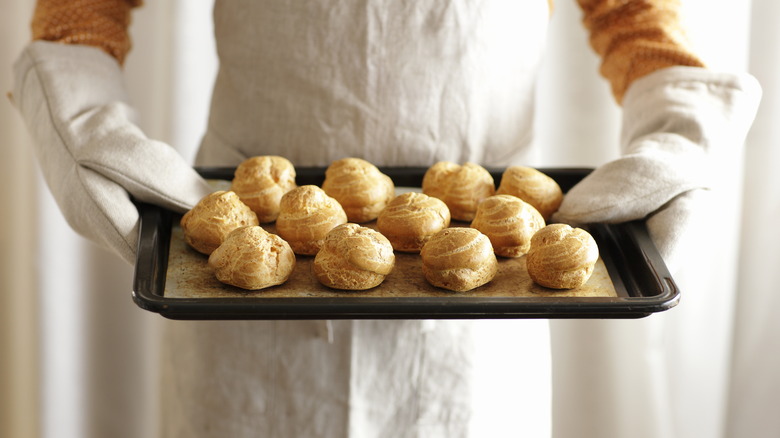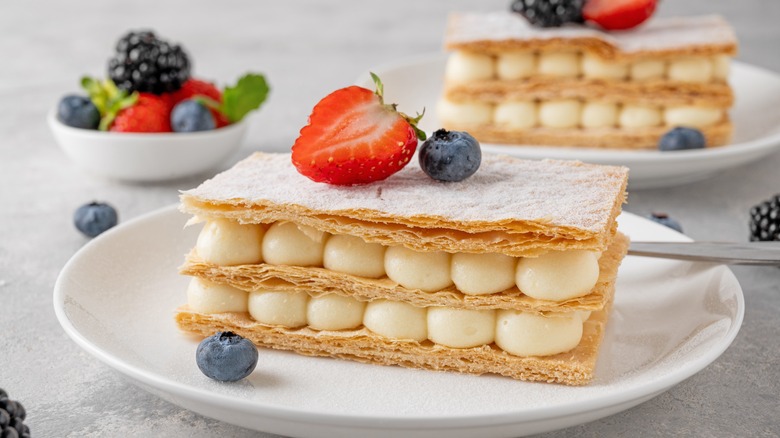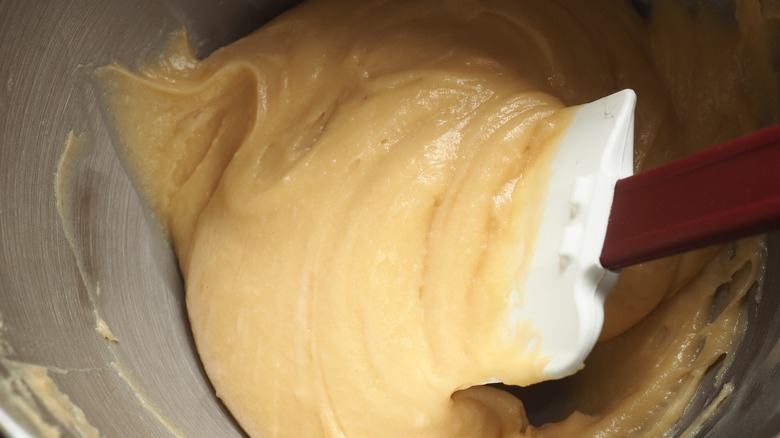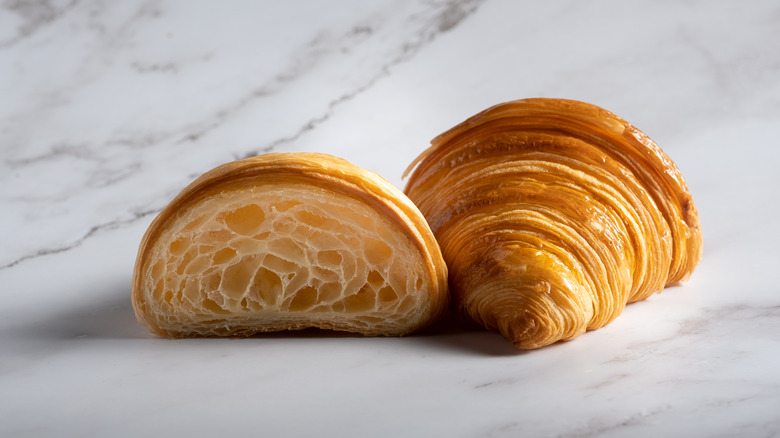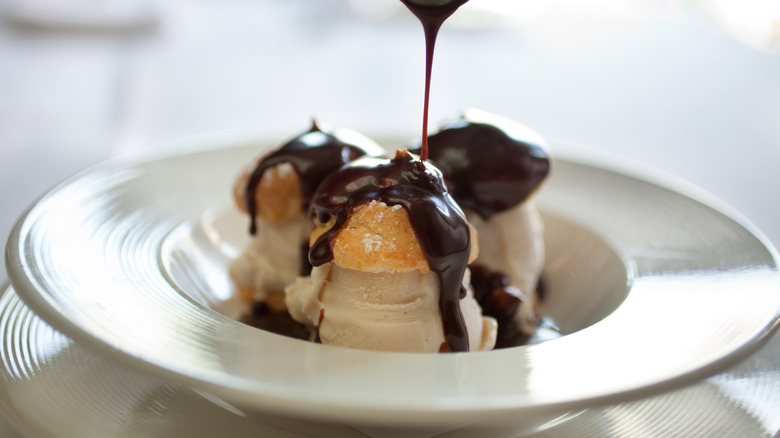Choux Vs Puff Pastry: The Difference, Explained
The world of baking is vast, filled with techniques that can stump even the most experienced baker. Two such baking challenges are puff pastry and choux pastry. These stars of the pastry case are the reason we have croissants, éclairs, napoleons, and profiteroles, and their magic comes from the power of steam — but in two very different ways.
Choux and puff pastry are both styles of dough that result in light, airy baked goods with a unique structure. They're icons of a French patisserie, and they pair perfectly with creamy custards (and a glass of champagne). They also both have savory applications, bringing that unmistakable lightness to appetizers and main courses. But there's so much that sets them apart.
Making puff pastry is a long process, requiring precise lamination and lots of patience. When it's cooked, puff pastry is crisp and flaky, filled with thin and delicate interior layers. Making choux pastry is much easier than it seems, with a dough that is soft enough to be piped and is cooked twice (once to hydrate the flour, and once to bake). Meanwhile, choux pastry creates a round and hollow baked good with giant air pockets and a sturdy shell. And while both types are airy and delicious, they are different in so many ways.
What is choux pastry?
Choux pastry, or pâte à choux, begins with a unique baking technique that is a lot easier than it sounds. Melted butter, milk, sugar, and salt are heated in a pan, then flour is added and the dough is stirred vigorously. The goal is to create a dough with the texture of dry mashed potatoes, hydrating the flour and eliminating excess moisture. Then, the pan is removed from the heat, and eggs are added, giving the dough strength and structure (plus a mild eggy flavor and a golden crust). The dough is soft enough to be piped into rounds, fingers, or even swans – remember those from "The Great British Baking Show"?
Once baked, choux pastry is puffed, golden, and firm to the touch. Inside, giant air pockets leave space for an endless array of fillings while a layer of eggy dough lines a crisp and firm exterior — the perfect canvas for a glaze or a crunchy layer of craquelin. That cavernous interior is thanks to a highly hydrated dough that produces lots of steam, trapped by the structured dough to make a pastry shell. Choux pastry is perfect for making filled and frosted éclairs, towering caramel-dipped croquembouche, or airy and cheesy gougères — sure to impress at your next cocktail party.
What is puff pastry?
Puff pastry intimidates even the most experienced home bakers, and for good reason. Making the dough requires a lot of precision, specific techniques, and some serious patience. Basically, you cannot make homemade puff pastry if you're in a rush. (The good news? It freezes really well, so make extra and save some for later).
The secret to puff pastry is all in the lamination. A simple dough is rolled out and wrapped around a block of butter, then the dough and butter are carefully rolled and folded to create delicate layers that will puff and flake when baked. Temperature is key — too cold and the butter will crack as you roll it, but too warm and it will ooze out instead of maintaining distinct layers between the dough. The dough needs to be refrigerated between turns (each time the dough is rolled and folded), so it's a process you really can't hurry. In a pinch? Even Ina Garten says store-bought puff pastry is an okay baking staple.
After baking, puff pastry has a crisp and flaky exterior, thin and delicate interior layers, and precise structure. Each layer is separated by steam from quickly heated butter, separating the dough and infusing the final pastry with rich flavor. Whether you're rolling croissants, slicing savory palmiers, or wrapping a mushroom duxelle around tenderloin for beef Wellington, that texture is unmistakable.
Choux pastry uses eggs
Traditional choux pastry has six or seven ingredients: Butter, milk and/or water, sugar, salt, flour, and eggs. Butter makes the pastry rich, milk or water provides moisture (milk also enhances browning), flour is what makes it a pastry, and sugar and salt are for flavor and seasoning. But it's really the eggs that are crucial to a successful choux pastry.
Without eggs, the dough wouldn't have the strength and structure to retain its puffed, rounded shape after baking, and it would likely collapse. The eggs also add additional moisture to the dough after the flour has absorbed all the butter and milk. This helps create a soft and pipeable consistency, as well as a smooth finish to the dough.
In puff pastry, the five basic ingredients are flour, sugar, salt, water, and butter. The gluten that gives the pastry structure is built during the lamination process, and the moisture in each butter layer turns to steam when baking to separate the dough into flaky sheets. There's no extra lift, and baked puff pastry is dramatically more delicate than a firm choux bun — you've seen all the flakes a croissant can rain down on your lap, right?
Puff pastry is laminated
Spotting the thin, buttery layers of dough in a laminated pastry is easy. Making laminated dough, on the other hand, is a challenge. After making a smooth and flexible dough, you use it to encase a block of butter that will eventually be responsible for those iconic layers. But how do you get there?
Once the butter is encased in dough, the whole thing is carefully rolled and folded multiple times, increasing the layers exponentially as you go. There are two folding techniques to choose from: The envelope fold and the book fold. For the former, roll the dough into a rectangle with a short end closest to you. Fold the bottom third of the dough up to cover the center, then fold the top third down, creating an envelope shape. For the latter, orient the dough with a long edge toward you. Fold each short edge in to meet in the middle, then fold the dough in half along the center seam like closing a book. Mathematically speaking, the book fold creates more layers at a time, but either technique is great.
Choux pastry, on the other hand, is not laminated. In fact, it's never even rolled out. A spoon or spatula is used to heartily stir flour into a mixture of melted butter and milk, then eggs are stirred in afterward. The dough is soft — softer than some cookie doughs — and must be piped or spooned onto a baking sheet.
Choux pastry can be filled
A hallmark characteristic of pâte à choux is the hollow center after it is baked. As choux pastry bakes, the moisture in the dough creates steam, causing the dough to rise and puff. Thanks to the way the flour is combined with the milk and butter, as well as the addition of eggs, the dough can stretch enough to capture that steam and is also strong enough to hold its shape when cooled. This means cooked choux pastry can be handled and manipulated, making a choux bun the perfect vessel for filling.
Choux pastry is often filled with something creamy like pastry cream, whipped cream, or ice cream. Yes, the pastry is tasty on its own, but it is really an edible vessel. When the buns come out of the oven, bakers encourage the buns to dry out by poking a hole in the bottom or cutting them open, releasing any trapped steam so the crust doesn't get soggy. This opening is later used to introduce the filling of choice.
Unlike the hollow interior of choux pastry, you can't put filling between the flaky layers of puff pastry, as each layer is thin and delicate. Instead, puff pastry is often layered with filling (like the layers of cream and fruit between sheets of crispy puff pastry in a millefeuille) or used as the crust for a pie or tart.
